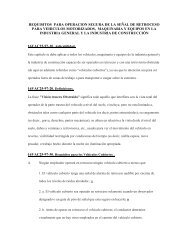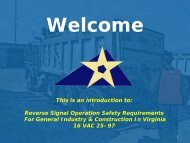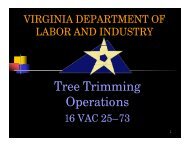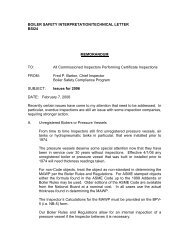VPP Self-Assessment Checklist - Virginia Department of Labor and ...
VPP Self-Assessment Checklist - Virginia Department of Labor and ...
VPP Self-Assessment Checklist - Virginia Department of Labor and ...
You also want an ePaper? Increase the reach of your titles
YUMPU automatically turns print PDFs into web optimized ePapers that Google loves.
<strong>Virginia</strong> Voluntary Protection Program (<strong>VPP</strong>) <strong>Self</strong> <strong>Assessment</strong><br />
<strong>Self</strong>-<strong>Assessment</strong> <strong>Checklist</strong><br />
The items listed below will help you determine your<br />
eligibility for the <strong>Virginia</strong> Voluntary Protection<br />
Program (<strong>VPP</strong>). Check each item that you currently<br />
have or would be willing to implement. If you are<br />
able to check every item, or could within a few<br />
months, you may be ready to apply for participation<br />
in the <strong>VPP</strong>.<br />
Injury <strong>and</strong> Illness Rates<br />
Your three-year average Total Case Incident Rate<br />
(TCIR) <strong>and</strong> Days Away, Restricted or Transferred<br />
(DART) rates must be below the rate published by the<br />
Bureau <strong>of</strong> <strong>Labor</strong> Statistics for your SIC code for at least<br />
one <strong>of</strong> the three most recently published years.<br />
TCIR <strong>and</strong> DART rates are calculated as using<br />
the formula (N/EH) X 200,000 where:<br />
N = number <strong>of</strong> recordable injuries <strong>and</strong> illnesses<br />
in one year<br />
EH = total number <strong>of</strong> hours worked by all<br />
employees in one year<br />
200,000 = equivalent <strong>of</strong> 100 full-time workers<br />
working 40-hour weeks, 50 weeks per year<br />
Management Commitment<br />
A managerial commitment to worker safety <strong>and</strong><br />
health protection<br />
Top management’s personal involvement<br />
Safety <strong>and</strong> health concerns integrated into<br />
management’s overall planning cycle<br />
Safety <strong>and</strong> health protection managed in the same<br />
ways as productivity <strong>and</strong> quality are managed<br />
A written safety <strong>and</strong> health program appropriate to<br />
the size <strong>of</strong> your site <strong>and</strong> your industry that address all the<br />
elements in this checklist<br />
A results-oriented safety <strong>and</strong> health policy<br />
Clearly assigned safety <strong>and</strong> health responsibilities<br />
with documentation <strong>of</strong> accountability from top<br />
management to line supervisors<br />
Adequate authority to carry out assigned<br />
responsibilities<br />
Necessary resources to meet responsibilities<br />
Quality protection for all contract employees equal<br />
to that provided for your own employees<br />
Employee involvement in activities that have a<br />
major effect on your safety <strong>and</strong> health program<br />
Annual safety <strong>and</strong> health program evaluations with<br />
written narrative reports, recommendations for program<br />
changes, action plans, <strong>and</strong> verification procedures<br />
Worksite Analysis<br />
A method such as comprehensive safety <strong>and</strong><br />
industrial hygiene surveys to identify existing or<br />
potential hazards in your workplace<br />
A pre-use analysis procedure for new processes,<br />
materials, or equipment to determine potential hazards<br />
Routine industrial hygiene monitoring <strong>of</strong> toxic<br />
substances <strong>and</strong> noise<br />
Monthly self-inspections with written<br />
documentation <strong>and</strong> hazard correction tracking<br />
Routine hazard analysis procedures which result in<br />
improved work practices or training for employees<br />
A written hazard reporting system whereby<br />
employees pass on their observations or concerns to<br />
management without fear <strong>of</strong> reprisal<br />
Accident investigations with written documentation<br />
Method <strong>of</strong> documenting all identified hazards until<br />
they are controlled or eliminated<br />
Analysis <strong>of</strong> injuries, illnesses <strong>and</strong> hazards to identify<br />
trends <strong>and</strong> implement program adjustments
<strong>Virginia</strong> Voluntary Protection Program (<strong>VPP</strong>) <strong>Self</strong> <strong>Assessment</strong><br />
Hazard Prevention <strong>and</strong> Control<br />
Access to certified safety <strong>and</strong> health pr<strong>of</strong>essionals<br />
Engineering <strong>and</strong> administrative controls adequate for<br />
the hazards at the workplace<br />
Written safety rules <strong>and</strong> practices that are<br />
understood <strong>and</strong> followed by all employees<br />
A consistent disciplinary system applied to all<br />
employees who disregard the rules<br />
Written rules for use <strong>and</strong> maintenance <strong>of</strong> personal<br />
protective equipment<br />
Review<br />
Your written safety <strong>and</strong> health programs <strong>and</strong> all<br />
documentation relating to the programs must be<br />
available for VOSH review.<br />
Concurrence<br />
Formal, signed statements from any collective<br />
bargaining agents indicating their support <strong>of</strong> your<br />
application to the <strong>Virginia</strong> Voluntary Protection<br />
Program. Where no collective bargaining agent is<br />
authorized, employees underst<strong>and</strong> the <strong>VPP</strong> <strong>and</strong> support<br />
participation.<br />
Written plans to cover emergency situations<br />
A hazard correction tracking procedure<br />
Onsite or <strong>of</strong>fsite medical <strong>and</strong> emergency services<br />
First-aid <strong>and</strong> CPR trained personnel on staff during<br />
all shifts<br />
Use <strong>of</strong> occupational health pr<strong>of</strong>essionals in hazard<br />
analysis as appropriate<br />
Documented ongoing monitoring <strong>and</strong> maintenance<br />
<strong>of</strong> workplace equipment<br />
Safety <strong>and</strong> Health Training<br />
Managerial, supervisory, <strong>and</strong> employee training,<br />
with emphasis on safety <strong>and</strong> health responsibilities<br />
Training in the use <strong>and</strong> maintenance <strong>of</strong> personal<br />
protective equipment<br />
Emergency preparedness drills, including annual<br />
evacuations<br />
Documentation <strong>of</strong> all training received, including<br />
assessment procedures









